Recreating the Country blog |
Acacia implexa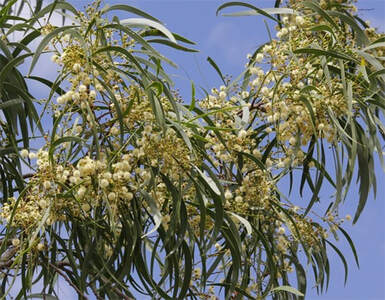 Pale yellow pompom flowers on a Lightwood Pale yellow pompom flowers on a Lightwood About thirty years ago, I set off to collect my first Lightwood seed on a roadside near Lethbridge. I had been tipped-off by a local farmer, who said that it grew alongside a shrubby form of Blackwood. I remember driving up and down the gravel road several times, wondering if I had been sent on a wild goose chase. The trees on the roadside all looked like Blackwoods through my open window. At this stage of my nursery career, I had only read about Lightwood and didn’t know about the subtle features that distinguished it from it's very close relative, Blackwood. Though, a walk amongst the roadside trees soon revealed that there were indeed two different species growing side by side. With a more experienced eye, I can now comfortably identify Lightwoods while driving along a country road or highway, and it has become one of my favourite medium-sized wattles. Commonly pronounced – im-plex-a (no surprises there) Its species name, ‘implexa’ hints at another distinguishing feature of the tree. Its spiralling seed pods form tangled clumps and look very like untidy bird’s nests hanging from the branches. Implexus is Latin for tangled. 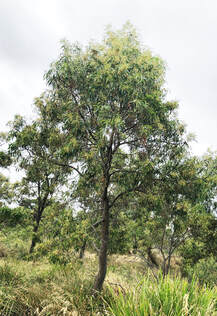 Where does it grow? & what does it look like? The Lightwood is well suited to the soils and rainfall of the Geelong region. It can also be found growing on the basalt plains west of Geelong on stony barriers, in the eastern parts of Victoria, NSW and southern Queensland where the rainfall above 450 mm. In areas with high rainfall like the Otway Ranges, it’s unlikely to be seen, but this is where Blackwood’s excel and grow into forest giants. The Lightwood is an attractive, hardy, drought, frost-tolerant, upright small tree that grows 5-10 m tall. Though very like the Blackwood, its leaves are greener and distinctly sickle shaped. 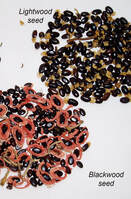 Another important difference between Lightwood and Blackwood is the seed. The glossy black seed of the Lightwood has a small bone coloured aril (the aril connects the seed to the pod) at the end of the seed, whereas the Blackwood has a large orange aril that surrounds the whole seed. The Lightwood has a rough bark and an attractive grey trunk. (click on the image to enlarge) 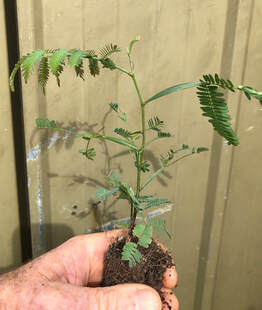 A Four month old Lightwood grown from seed and ready to plant A Four month old Lightwood grown from seed and ready to plant The Lightwood is quite long-lived, thriving for 30 – 50 years. It still can be found on roadsides and on stony barriers, though it is becoming rarer. It’s more adaptable than the Blackwood and does well in dry, windy, exposed locations. The Lightwood is suited to all well drained soils. It's a fast-growing tree and will commonly reach two meters tall in the first twelve months after planting. The Lightwood is therefore very useful for erosion control, and its potential to sucker when its roots are disturbed is another benefit in eroded landscapes. Its tendency to sucker makes me cautious about recommending it for small gardens. Because it is a handsome tree, it is often planted as a street tree. An added benefit is its tolerance to pollution, and its shallow roots don’t raise footpaths. For a more detailed description of the leaves, flowers and seed pods, click to this Flora bank link Practical uses for the tree and its timber Its dense foliage makes it an ideal tree to plant for shelter on farms and as an understorey planting near remnant tall eucalypts like Yellow Gum and River Red Gum. Like all wattles, Lightwoods fix atmospheric nitrogen in the soil. This benefits all plants growing nearby. In Biorich plantations (designed for biodiversity and for income) it can be planted in clumps of 20 or more to allow for future maintenance and harvesting timber. Straight trees can be selected and ‘form-pruned’ to improve the future value of their harvested wood. 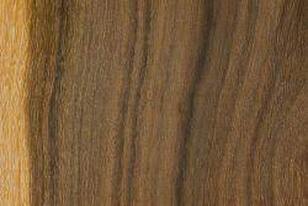 The beautiful grain of Lightwood timber The beautiful grain of Lightwood timber ‘Form-pruning’ removes small branches from the main trunk, producing knot-free timber called clear-wood. Clear-wood is stronger and more valuable to furniture makers and wood turners because of its continuous, uninterrupted wood grain. Lightwood timber is hard, close-grained and dark brown with some pale stripes. The smaller branches and waste timber are also good firewood and are hot burning. Its lemon coloured pompom flowers in late summer provide good quality protein rich pollen for bees (crude protein is 23% - 27%). 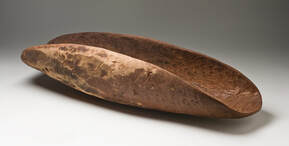 Coolamon. Photo National Museum Australia Coolamon. Photo National Museum Australia Traditional owner uses The very hard timber would have been useful for making Clapsticks and for carving small wooden bowls like the Coolamon. Traditional Owners boiled the bark of the Lightwood to produce a lotion that was applied to wounds to aid healing. This lotion could also relieve painful muscles and bruising. The leaves and bark are rich in soap forming chemicals called saponins. These produce a foam when crushed and mixed with water and were used to stun and catch fish. Nature notes The upright branching habit of the Lightwood provides excellent roosting sites for birds. Parrots and native pigeon’s eat the seed pods and seeds. Smaller birds like Silvereyes, feed on the many insects that are attracted to the late summer pollen rich flowers. Other insect eating birds like the Black-faced Cuckoo Shrike feed on grubs found under the bark. Like many wattle species, Lightwood is prone to attack from borers and gall forming wasps. The galls appear as brown, rounded woody growths on the branches. They can indicate that the tree is unhealthy (heavy clay soil or poor drainage can cause stress) or getting old. The galls can be cut off and burnt if they become unsightly.  A tangle of dry Lightwood pods with visible glossy black seeds. A tangle of dry Lightwood pods with visible glossy black seeds. Propagation from seed The most convenient method to separate the acacia pods from the seed is to shake and rub the opened pods through a common garden sieve, a few handfuls at a time. Winnowing in a light breeze will remove the fine trash that passes through the sieve with the seed. After the Lightwood seeds are collected and cleaned. They can then be stored indefinitely in a jar or a zip lock plastic bag. Always record the date and place of collection. To germinate the seed, place the seed in a cup and pour boiled water over the seeds until they are well covered. Any seeds that float can be discarded because they are infertile. Allow the water to cool, pour off the water and pat the seeds dry. 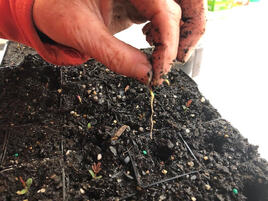 Acacias are best transplanted at a very early stage after germination Acacias are best transplanted at a very early stage after germination Sow in a shallow tray and cover the seed with potting mix. They should start to germinate within two weeks. Transplant into cells or forestry tubes when they are small and easy to handle. Add a pinch of slow release native plant fertiliser. Inoculating with rhizobia will increase the vigour and health of your trees when they are planted on in the field. Click here and scroll down for an easy acacia inoculation method. Grow plants on until they are about twice the height of the tube/cell and well hardened-off (toughened).
3 Comments
Veni
18/1/2024 01:05:15 pm
Amazing, thank you so much for writing this up. We have these planted in our new development (really close to the wall though). It was notoriously hard to find in detail information about the tree and you've given me such a wealth of knowledge.
Reply
Dan
19/7/2024 12:21:19 am
Thanks for the wealth of information. Planting one of these and greatly appreciate it!
Reply
Leave a Reply. |
Click on the image below to discover 'Recreating the Country' the book.
Stephen Murphy is an author, an ecologist and a nurseryman. He has been a designer of natural landscapes for over 30 years. He loves the bush, supports Landcare and is a volunteer helping to conserve local reserves.
He continues to write about ecology, natural history and sustainable biorich landscape design. 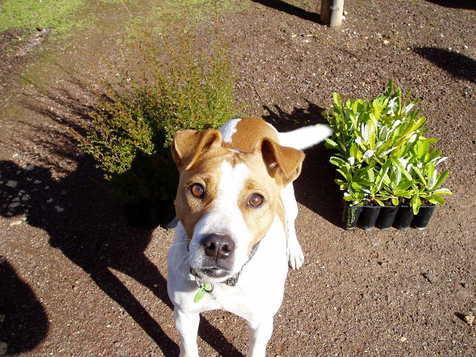
|
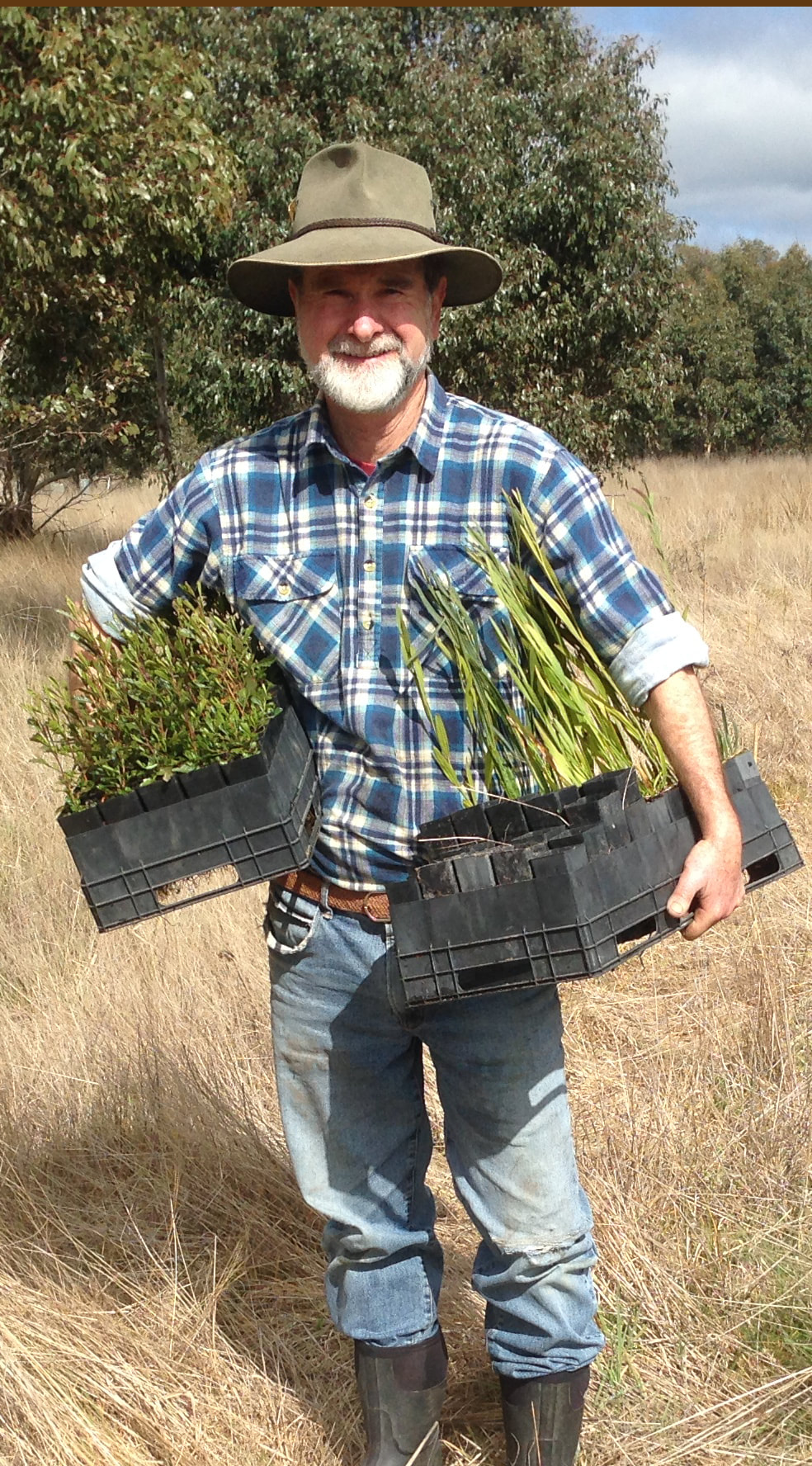

 RSS Feed
RSS Feed
